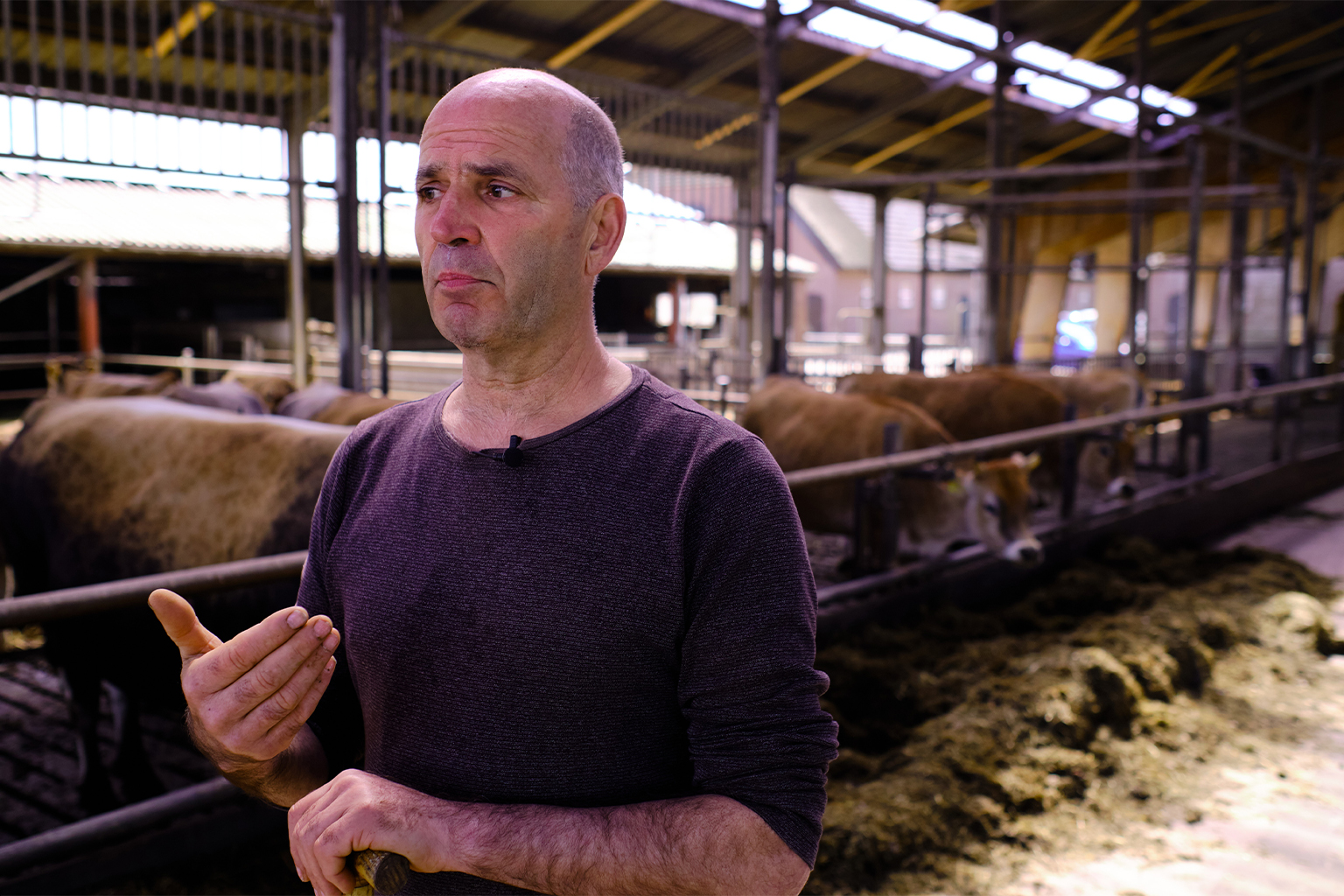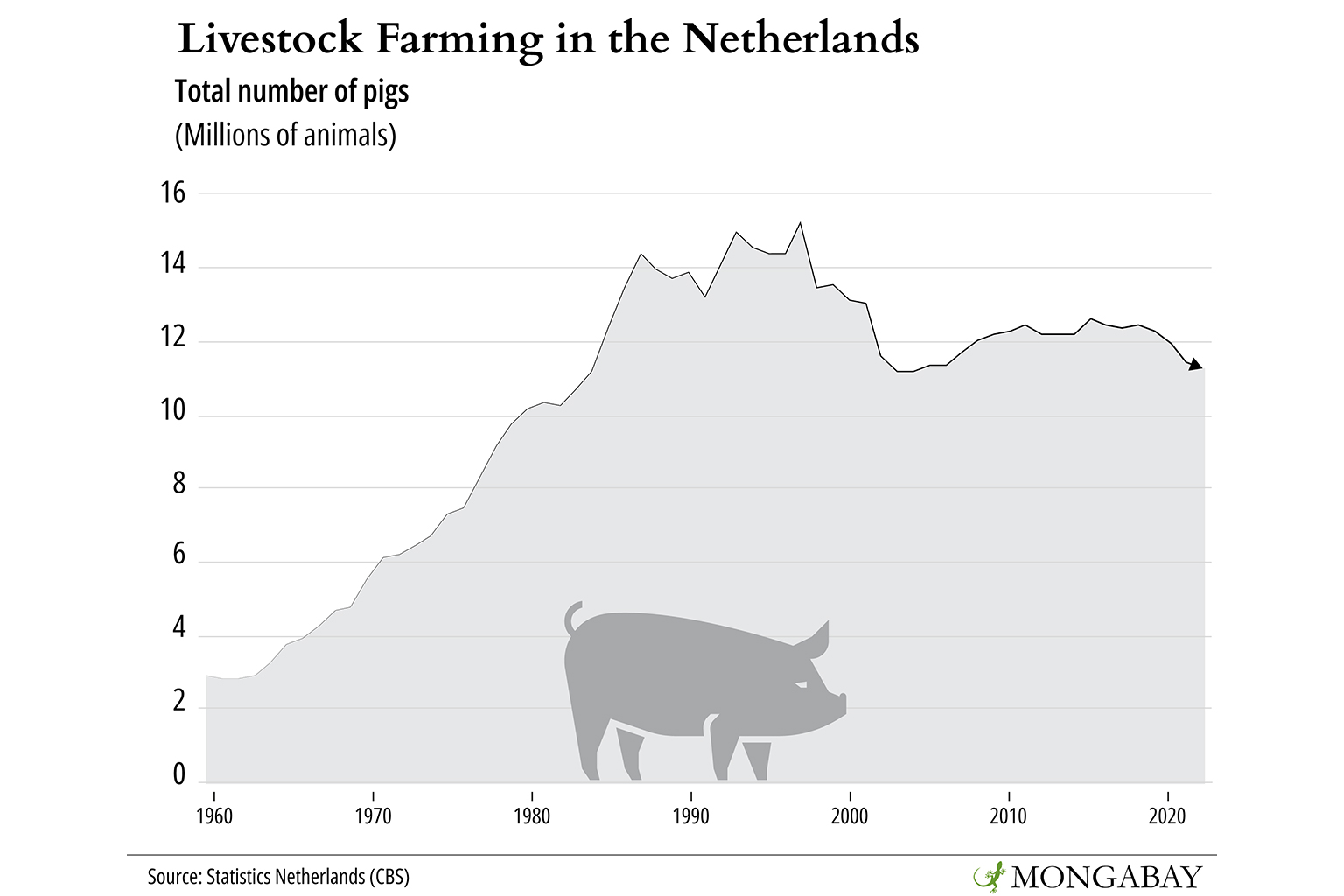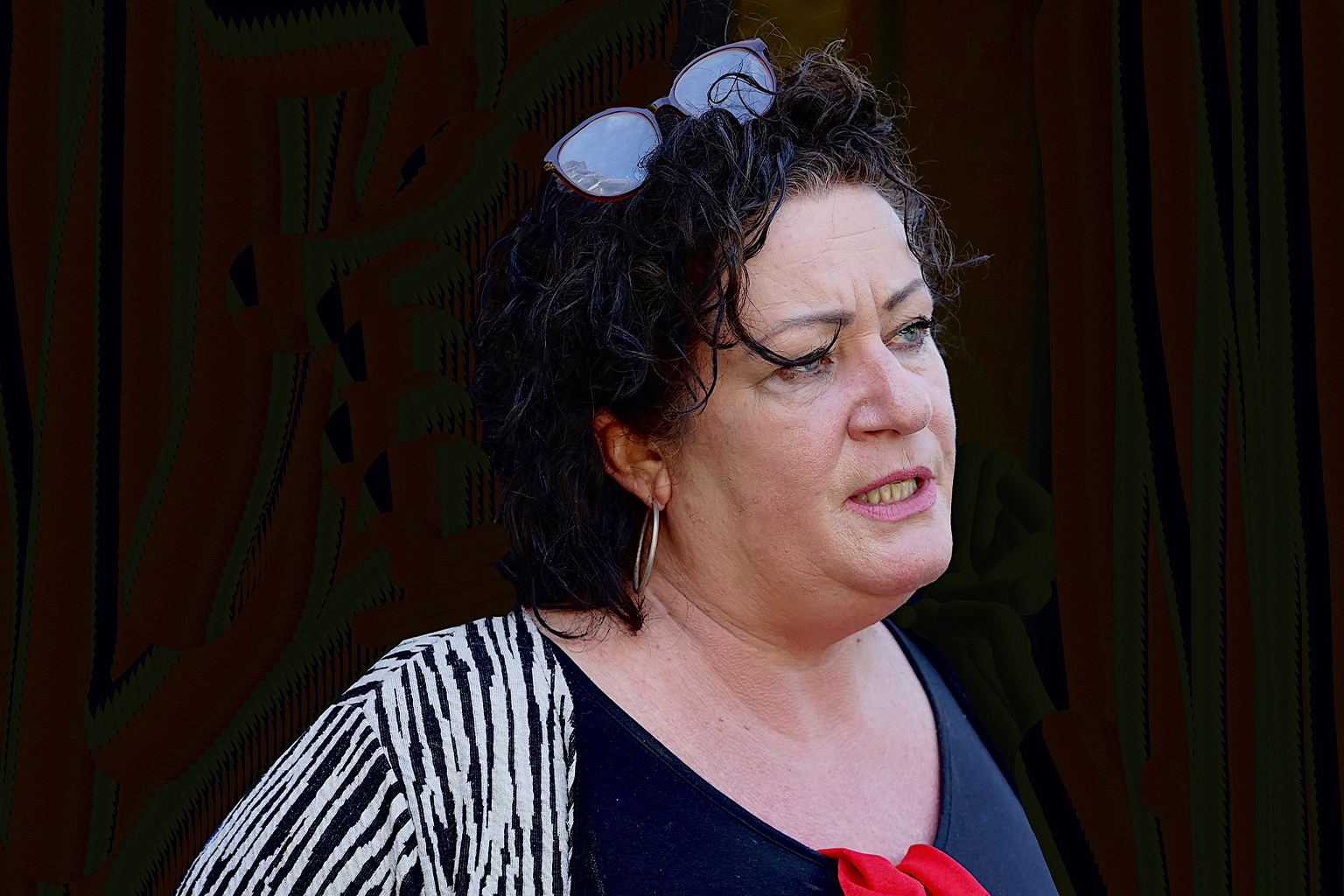- In response to a court ruling, the Dutch government announced in 2022 that it would aim to halve emissions of nitrogen from livestock like cows, pigs, and chickens.
- The announcement enraged farmers in the country and sparked a massive protest movement that upended Dutch politics.
- For years, farmers in the Netherlands were encouraged to produce more milk, eggs, and cheese to meet Dutch export targets.
- The sudden u-turn and subsequent backlash gave rise to a new political party in the Netherlands, the Farmers-Citizens Movement, which swept provincial elections in March.
This is the second story in a three-part Mongabay miniseries on the Dutch nitrogen crisis and farmer protests of 2022: How EU conservation rules shook up Dutch politics. Read Part One and Part Three.
LUNTEREN, Netherlands — Jan Dirk’s dairy farm in Lunteren, about a 30-minute drive from De Hoge Veluwe National Park, has the look of a Dutch postcard. Next to a rustic brick building with a thatched roof, brown-and-white dairy cows graze on a field pockmarked with wildflowers.
Dirk squats on the grass, rubbing dirt between his fingers and talking about the mycorrhizae fungi in it that keeps his soil healthy. Behind him, his dog faces off playfully with one of the cows, which reciprocates in turn. Farming is in Dirk’s bones. He’s the 13th generation of his family to work this land. When he took over the farm, it was an example of all the post-war trends in Dutch farming: intensive production, genetically modified herds, heavy use of imported feed.
“I was really the biggest in cows,” he said, comparing himself to his neighbors at the time. “And I used a lot of artificial nitrogen, so I got high yields from the field. I was the first one with an irrigation system, and I’d dehorn my cows for housing in cubicles. We invested a lot, but after some years, I thought, ‘This is not really what I want.’”

About two decades ago, Dirk started farming organically, leaving what he calls the “technical” system behind. Now he refuses to give his cows antibiotics, and feeds them grass from the pasture rather than soy-based imports. It was a radical break, and laughing, he says his neighbors sometimes ask around if it’s true that his cows actually produce milk.
“I’m not against a technical system — I was raised in a technical system,” he said. “But I want to show people that there are other opportunities.”
Dirk wasn’t active in last year’s protests, when tens of thousands of his fellow farmers flooded the roads in opposition to the Dutch government’s plans to reduce nitrogen emissions from livestock farms. But he says he understood where his peers were coming from. In the run-up to the protests, he sighs, policymakers made “so many mistakes.”
“The farmers are the victims of this whole system,” he said, surrounded by pungent wheels of aging cheese. “And the agri-industry is earning the money. The farmers don’t, but they do the hard work. They’re raised up with this idea that keeping more animals and having higher production levels is how you earn more money. So they invest a lot to get there, and then they have to pay it back, with interest.”

From mulch to march
The Dutch government’s announcement last year that it was planning a 50% cut in nitrogen emissions by 2030 sent shockwaves through the countryside. The only way to achieve a reduction that deep, on such a short time line, would be buyouts and shutdowns for farms near nature reserves.
Years of middling progress on shrinking the toxic clouds of ammonia created by livestock manure had run the Netherlands afoul of EU biodiversity rules. But now, Dutch leaders had to take action fast, or the country would face fines, litigation, and more court-ordered shutdowns of construction projects.
The threat of incoming buyouts and mandated livestock cuts sent farmers in the Netherlands into a rage. When the government announced its new reduction targets, WhatsApp groups and Facebook pages associated with farmers’ organizations like Agractie and the more militant Farmers Defence Force sprang into action. Within days, processions of tractors were rolling through rural provinces, banners draped on their grilles that said “No Farmers, No Food.” On highways in the countryside, some demonstrators dumped piles of manure and lit them on fire.


The scale and fury of the protests shocked the Netherlands. Clips of angry farmers at rallies warning of food shortages circulated on the internet, eagerly absorbed by the borderless digital churn of social media. To many pundits and figures on the political right, the protests took on a larger, global significance: the farmers weren’t just pushing back against Dutch regulatory overreach, they were fighting “elites” who they claimed were using climate and environmental scaremongering to impose a radical agenda.
Right-wing firebrand Geert Wilders and his French counterpart, Marine le Pen, expressed support for the demonstrations, as did Donald Trump, who warned that U.S. farmers were next up in the crosshairs of “climate fanatics.” Russell Brand released a viral video laden with bizarre conjectures, claiming the plan was to “bankrupt farmers so their land can be grabbed.” In the Netherlands, more extreme wings of the farmers’ movement hinted at shadowy conspiracies at play, alleging that the World Economic Forum was using nitrogen as a Trojan horse to bring about its “Great Reset.”
For the most part, those voices lay at the fringe. The majority of farmers weren’t interested in a showdown with “globalists”; they were worried about their livelihoods. The Dutch government had long known nitrogen deposition was destroying ecosystems in the country. But instead of drawing up long-term plans to reform agricultural production before the situation worsened, it designed an ineffective emissions-trading scheme that favored big business.
When the courts finally blew the scheme up with a 2019 ruling that compelled the government to call for cuts in nitrogen emissions, it was the farmers, most of whom had studiously followed the rules, who were closest to the blast zone. “It was mostly smaller farms that were by one stroke illegal,” said Bram van Liere of the Dutch environmental group Milieudefensie. “And those farmers probably acted on good faith and within the regulations at that time … They were basically pushed in front of the bus by the government’s scheme and the large agricultural sector.”

Bigger stables, narrow margins
Since the first tractor rolled out to protest in 2019, the primary target of farmers’ ire has been the Dutch government. Historically speaking, this is either a great irony or a long-overdue backlash, depending on one’s perspective. The modern Dutch farm is, in fact, a direct creation of government policy and social engineering in the Netherlands.
Agriculture in the country today is a juggernaut of efficiency and production, generating 80 billion euros’ ($86 billion) worth of exports in 2022 alone, nearly a quarter of which came from dairy, meat and eggs. But it wasn’t always this way.
In the 1950s, Dutch policymakers worried that farmers in the Netherlands were falling behind the rest of its workforce. So figures like then-agriculture minister Sicco Mansholt, who would one day go on to become the godfather of the EU’s Common Agricultural Policy, designed a plan to consolidate smallholder farms and push unproductive farmers off their land in favor of larger, more efficient enterprises.
The policy was a wild success. Between 1945 and today, the overall number of farmers in the Netherlands dropped from 400,000 to 54,000, but the size of remaining farms skyrocketed. In 1950, most dairy farms held only a dozen or so cows. By 1980, it was 40, and then 105 in 2020.


The boom was great for the Dutch trade balance, but it came at the expense of the environment. And by some metrics, it wasn’t all that great for most farmers either.
“Farmers are led to believe that they’re entrepreneurs like any other big business, but they are not,” said Jan Slomp, who ran a dairy and pig farm in the 1980s before moving to Canada. “They are very much squeezed between real estate costs, operating costs, and narrow margins. It’s such an unfair system.”
On paper, many farmers in the Netherlands are wealthy. Twenty percent of the country’s millionaires are farmers, but it’s a deceptive statistic. The price of land in the Netherlands is sky-high, so farmers are often land-rich but cash-poor. On average, they’re more than 1.3 million euros ($1.4 million) in debt, mostly to Rabobank, the country’s largest agricultural financier, and they earn a yearly take-home salary of just 60,000 euros ($65,000). Over the past two decades, the debt burden of a dairy farmer has doubled, but their income in that period has dropped slightly.
Without massive subsidies from the EU, few would be able to survive financially.
The Dutch agrifood industry, on the other hand, is immensely profitable. Farmers do the day-to-day work of milking cows, slaughtering pigs and collecting eggs, but they’re at the bottom of a production chain that includes feed suppliers, pharmaceutical companies, marketing cooperatives, machinery providers, supermarkets and banks. In 2022, the feed giant ForFarmers banked 500 million euros ($540 million) in profit. The investigative outlet Follow The Money estimated Rabobank made around 300 million euros ($324 million) from its agricultural portfolio in 2020.
As the saying goes in the Netherlands, farmers don’t have a business model; they are a business model.
Circling the barns
For major portions of the agricultural industry, it’s a business model that’s currently under threat. If the livestock herd is reduced, companies that sell machinery, antibiotics, feed and other products would inevitably see cuts to their bottom line.
That threat isn’t distant or theoretical, either. Since 2018, ForFarmers’ stock price has dropped by nearly 75%, slashing almost three-quarters of a billion dollars in shareholder value. Unsurprisingly, it isn’t sitting on its hands.
According to an investigation by Follow the Money, ForFarmers and other feed traders are among the funders of a platform called Agrifacts, which contests the scientific consensus around nitrogen deposition and attacks journalists who write about Dutch agriculture’s environmental impacts.
“I don’t think there is a nitrogen problem,” the group’s director, a well-known agricultural industry lobbyist, has said.
“The agro-industrial sector has been copying many tactics from the tobacco industry,” said Jeroen Candel, an associate professor at Wageningen University & Research. “There are these front groups and think tanks which are basically there to spread disinformation and cast doubt.”

Behind the placards, big companies in the livestock industry have also encouraged and supported the farmers’ protests. In 2019, the founder of Agractie, one of the farmers’ groups most active in coordinating those protests, told a reporter that ForFarmers had approached him when he was “all alone” and “jumped in at lightning speed.”
ForFarmers has acknowledged paying for a communications firm to help shape Agractie’s messaging strategy and expand its online presence. Along with Triolet, a Dutch livestock feeding machine supplier, it’s also known to have provided direct financial support for some of the protests.
“We thought, now something needs to be done. This cannot continue,” the director of Triolet said in 2019.
ForFarmers didn’t respond to a request for comment by Mongabay. But a spokesperson for the Farmers Defence Force, another farmers’ association active in the protests, said in an email that they “approach individual people and companies who are in farming” for support with their events, describing it as no different from NGOs soliciting donations for their own work.
“Donations are voluntary and free of conditions for us: we do not make any commitments to people who assist us financially,” the group wrote.

Farmer protests in the Netherlands are fueled by precarity and fear, but they’ve also fit neatly into the agrifood industry’s efforts to lobby against environmental measures that threaten the bottom line. And companies linked to that effort have cast a wide net. As the first protests erupted in 2019, a marketing agency with a decades-long track record of designing campaigns for agricultural corporations, ReMarkAble, set out on a new venture with Caroline van der Plas, an ex-journalist who once covered the dairy industry.
Watching the farmers’ cause resonate across the Dutch countryside, they’d seen an opportunity. In their view, the moment was ripe for a new political party that would represent not just the interests of farmers, but those of their much wider group of supporters. That party, called the BoerBurgerBeweging — BBB for short, or “Farmer-Citizen Movement” in English — would shake the foundation of Dutch politics.

An earthquake in the countryside
As votes rolled in on the night of March 15, 2023, it didn’t take long for it to became clear that a seismic event was taking place. Founded less than four years earlier, the BBB was on its way to a stunning upset victory. Running explicitly against Prime Minister Mark Rutte’s nitrogen strategy, party leader van der Plas portrayed the plan as emblematic of a government that was unconcerned with the welfare of “normal citizens” and captured by elite interests.
In the BBB’s first-ever election, one characterized by unusually high turnout and widely seen as a referendum on Rutte’s rule, it won a bigger share of the vote than any other party in the Netherlands. Gaining 16 out of 75 seats, overnight the BBB went from an insurgent outsider’s movement to the largest single party in the Dutch Senate.
“They already couldn’t ignore us. But now they definitely can’t,” cheered van der Plas.
Opposition to the government’s nitrogen plans was at the root of the BBB’s campaign. But years of underinvestment in rural infrastructure, government scandals, and a widening geographical divide in the Netherlands proved to be fertile ground for the BBB’s message of resentment and fury. Its appeal extended far beyond the farmers; around 1.4 million people voted for the party in the end, a bloc 25 times larger than the country’s 54,000 farmers.
“Most of [the voters] are non-academically certified, so they did vocational training or left school right after the secondary level. Part of them were living in the outskirts of large Dutch cities, and they were overconcentrated in the places that don’t matter, the in-between places,” said Ewald Engelen, a professor of social and behavioral sciences at the University of Amsterdam, who wrote about the election’s significance.
Almost immediately, the BBB’s shocking win upended the Dutch cabinet’s plans for addressing the nitrogen crisis. Badly beaten at the polls and facing a no-confidence vote in parliament, Rutte agreed to hit pause on the plans and signaled that his government was open to pushing back the emissions reduction deadline from 2030 to 2035.

For those who’d hoped the 2019 court ruling meant that Dutch ecosystems might have a fighting chance to recover, the election was a disaster.
“We were really happy with the ambition of reducing [nitrogen] by 50% in 2030, but now again we have the discussion of whether or not you can take more time,” said Kirsten Haanraads of WWF Netherlands. “What we see is that for certain specific nature areas, the ones that are most vulnerable to nitrogen, any delay is really difficult to justify.”
Bruised but not broken, Rutte vowed to continue pushing for a compromise that would keep the Netherlands in line with EU rules and protect the environment.
Since late 2022, his cabinet had been deep in high-stakes negotiations with the national farmers’ union and other industry representatives over the future of Dutch agriculture. The cabinet hoped that despite the BBB’s win, it could still hammer out an agreement that would solve the nitrogen crisis and put the country’s farmers on a road to ecological sustainability.
But what Rutte’s cabinet didn’t know was that its electoral disaster had chipped away at the foundation of an already shaky ruling coalition. Before long, the whole house was going to collapse.
Banner image: Farmers protest at The Hague against the government’s nitrogen plans in 2019. Image by Nancy Beijersbergen / Shutterstock.com
Read Part 3 of Mongabay’s miniseries on the Dutch nitrogen crisis: where does farming in the Netherlands — and Europe — go from here?
